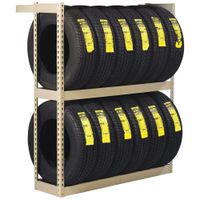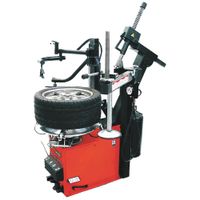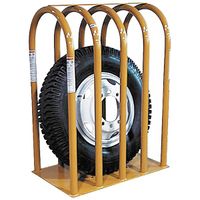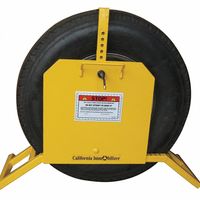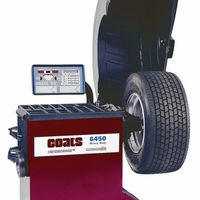Call +(254) 703 030 000 / 751 483 999 / 721 704 777
- Home
- Fleet Vehicle Maintenance
- Garage Equipment
- Tire Wheel Equipment
Tire & Wheel Equipment
Tire and wheel equipment helps maintain and store tires, wheel assemblies, and components. Garage storage racks provide a central storage area to organize tires and wheel components. Wheel balancing machines and accessories evaluate the distribution of tire weight in a wheel assembly and identify ar .....Read More
Frequently Asked Questions
What is the best way to store tires in a garage?
To store tires in a garage effectively, follow these steps:
1. **Clean and Dry**: Before storage, clean the tires with water and mild soap to remove dirt and debris. Ensure they are completely dry to prevent moisture-related damage.
2. **Bagging**: Place each tire in an airtight plastic bag, such as a lawn or leaf bag. Remove as much air as possible before sealing to minimize exposure to oxygen.
3. **Avoid Sunlight**: Store tires away from direct sunlight, as UV rays can degrade the rubber. A dark corner of the garage is ideal.
4. **Temperature Control**: Keep the storage area cool and dry. Extreme temperatures can cause the rubber to crack or degrade.
5. **Positioning**:
- **Without Rims**: Store tires upright to maintain their shape and prevent flat spots. Rotate them occasionally.
- **With Rims**: Stack tires horizontally, but no more than four high to avoid deformation.
6. **Avoid Chemicals**: Keep tires away from chemicals, solvents, and ozone-producing equipment like furnaces or electric motors, which can damage the rubber.
7. **Elevate**: If possible, store tires off the ground on a pallet or shelf to protect them from moisture and pests.
8. **Labeling**: Mark each tire with its previous position on the vehicle (e.g., front left) to ensure proper rotation when reinstalled.
By following these guidelines, you can extend the life of your tires and ensure they remain in good condition for future use.
How do wheel balancing machines work?
Wheel balancing machines work by detecting imbalances in a wheel and tire assembly to ensure smooth and safe vehicle operation. When a wheel is not balanced, it can cause vibrations, uneven tire wear, and stress on suspension components. Here's how these machines function:
1. **Mounting the Wheel**: The wheel and tire assembly is mounted onto the machine's spindle. The machine secures the wheel in place, often using a cone or collet system to ensure it is centered accurately.
2. **Spinning the Wheel**: The machine spins the wheel at a high speed, simulating the conditions the wheel would experience on the road. This can be done using an electric motor within the machine.
3. **Sensors and Data Collection**: As the wheel spins, sensors within the machine measure the distribution of weight around the wheel. These sensors detect vibrations and the amount of imbalance, which is typically measured in ounces or grams.
4. **Calculating Imbalance**: The machine's computer analyzes the data from the sensors to determine the location and magnitude of the imbalance. It calculates how much weight needs to be added or removed to achieve balance.
5. **Displaying Results**: The machine displays the results on a screen, indicating where corrective weights should be placed on the wheel. It often provides a visual guide to assist the technician in applying the weights accurately.
6. **Applying Weights**: The technician applies small weights to the wheel's rim at the specified locations. These weights counteract the imbalance, ensuring even weight distribution.
7. **Verification**: After the weights are applied, the wheel is spun again to verify that the imbalance has been corrected. If necessary, adjustments are made until the wheel is properly balanced.
By ensuring that wheels are balanced, these machines help improve vehicle handling, extend tire life, and enhance overall driving comfort.
What are the benefits of using tire changing machines?
Tire changing machines offer several benefits that enhance efficiency, safety, and precision in automotive maintenance. Firstly, they significantly reduce the time required to change tires compared to manual methods. This efficiency is crucial in high-volume service centers where time is of the essence. Secondly, these machines minimize the physical strain on technicians, reducing the risk of injury associated with manual tire changing, such as back strain or hand injuries.
Precision is another key advantage. Tire changing machines ensure that tires are mounted and balanced accurately, which is essential for vehicle safety and performance. Properly balanced tires lead to smoother rides and reduce uneven tire wear, extending the lifespan of the tires. Additionally, these machines are equipped to handle a wide range of tire sizes and types, including low-profile and run-flat tires, which can be challenging to change manually.
Safety features in modern tire changing machines, such as bead breakers and inflation systems, further enhance the safety of the operation by preventing tire and rim damage. This is particularly important for expensive alloy wheels, where manual methods might cause scratches or dents.
Moreover, tire changing machines contribute to a professional service image, as customers perceive the use of advanced equipment as a sign of quality and reliability. This can enhance customer satisfaction and loyalty.
In summary, tire changing machines offer time efficiency, reduce physical strain, ensure precision and safety, accommodate various tire types, and enhance the professional image of service centers, making them an invaluable tool in the automotive industry.
How do tire inflation cages enhance safety?
Tire inflation cages enhance safety by providing a protective barrier between the operator and the tire during the inflation process. These cages are designed to contain the force of an explosion if a tire fails or bursts, which can occur due to over-inflation, structural defects, or improper seating of the tire bead. The robust construction of the cage, typically made from heavy-duty steel, absorbs and redirects the energy from the explosion, preventing debris and high-pressure air from reaching the operator.
The use of tire inflation cages is crucial in preventing serious injuries or fatalities. When a tire explodes, it can release a tremendous amount of energy, propelling fragments at high speeds. The cage acts as a shield, ensuring that these fragments do not cause harm. Additionally, the cage encourages proper safety practices by requiring the operator to stand clear of the tire during inflation, reducing the risk of injury from sudden tire failure.
Tire inflation cages also promote consistent and safe inflation procedures. They often come with guidelines and pressure limits, ensuring that tires are inflated within safe parameters. This reduces the likelihood of over-inflation, which is a common cause of tire explosions.
In summary, tire inflation cages are a critical safety tool in tire maintenance and repair operations. They protect operators from the dangers of tire explosions, enforce safe working distances, and encourage adherence to proper inflation techniques, significantly reducing the risk of accidents and injuries in the workplace.
What is the purpose of wheel boot locks?
Wheel boot locks, commonly known as wheel clamps or wheel boots, are devices used to immobilize vehicles. Their primary purpose is to enforce parking regulations and deter unauthorized or illegal parking. By securing a vehicle's wheel, these devices prevent the vehicle from being driven away, ensuring compliance with parking rules.
Wheel boot locks serve several key functions:
1. **Parking Enforcement**: They are used by parking authorities and private property owners to enforce parking restrictions. Vehicles parked illegally or without proper permits can be immobilized until fines are paid or permits are obtained.
2. **Revenue Collection**: By immobilizing vehicles, authorities can ensure that parking fines are paid. This can be a significant source of revenue for municipalities and private parking operators.
3. **Theft Deterrence**: Wheel boots can also act as a deterrent against vehicle theft. Immobilizing a vehicle makes it difficult for thieves to drive it away, thus providing an additional layer of security.
4. **Traffic Management**: In areas with high traffic congestion, wheel boots can be used to manage parking and ensure that spaces are available for authorized users.
5. **Property Protection**: Private property owners use wheel boots to protect their property from unauthorized parking, ensuring that parking spaces are available for tenants, customers, or authorized personnel.
Overall, wheel boot locks are an effective tool for managing parking, enforcing regulations, and enhancing security. They provide a visible and physical deterrent to unauthorized parking and vehicle theft, ensuring compliance with parking rules and regulations.
How often should tires be balanced?
Tires should typically be balanced every 5,000 to 7,500 miles, or whenever you notice symptoms of imbalance such as vibrations in the steering wheel, seat, or floorboard, uneven tire wear, or after a tire rotation. It's also advisable to balance tires when new tires are installed, after a flat repair, or if you experience a significant impact like hitting a pothole. Regular balancing ensures even weight distribution around the tire and wheel assembly, promoting a smoother ride, extending tire life, and improving vehicle performance. Always refer to your vehicle's owner manual for specific recommendations.
What are the key features to look for in a tire storage rack?
When selecting a tire storage rack, consider the following key features:
1. **Capacity and Size**: Ensure the rack can accommodate the number and size of tires you need to store. Check the weight capacity to ensure it can support the tires without risk of collapse.
2. **Material and Durability**: Look for racks made from high-quality materials like steel or heavy-duty metal, which offer durability and resistance to wear and tear. Rust-resistant coatings are also beneficial for longevity.
3. **Adjustability**: Adjustable racks allow for flexibility in storing different tire sizes and can be modified as your storage needs change.
4. **Stability and Safety**: The rack should have a stable base and secure anchoring options to prevent tipping. Safety features like locking mechanisms or straps can help keep tires securely in place.
5. **Space Efficiency**: Consider the design of the rack to ensure it maximizes space usage. Wall-mounted or vertical racks can save floor space, while stackable options can increase storage capacity.
6. **Ease of Assembly and Installation**: Choose a rack that is easy to assemble with clear instructions. Some may require professional installation, while others are designed for DIY setup.
7. **Mobility**: If you need to move the rack frequently, look for models with wheels or casters. Ensure they have locking mechanisms to keep the rack stationary when needed.
8. **Versatility**: Some racks offer additional features like adjustable shelves or the ability to store other items, providing more utility.
9. **Cost**: Balance your budget with the features offered. While cheaper options may be tempting, investing in a quality rack can save money in the long run by avoiding replacements.
10. **Brand Reputation and Reviews**: Research brands and read customer reviews to ensure reliability and satisfaction with the product.
